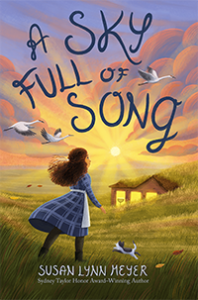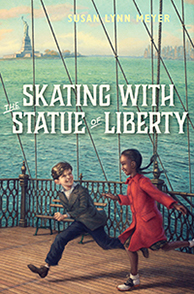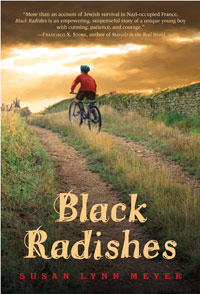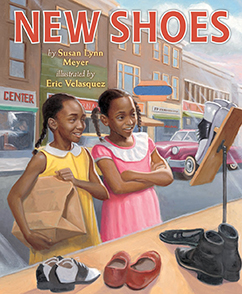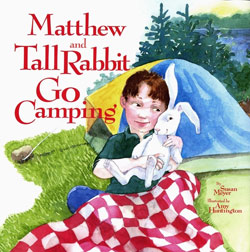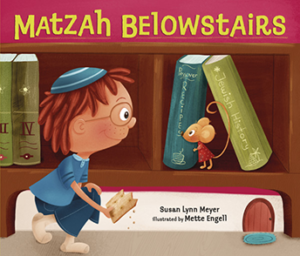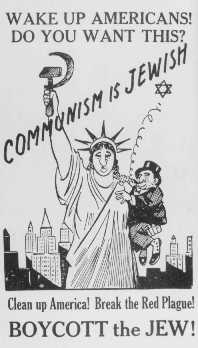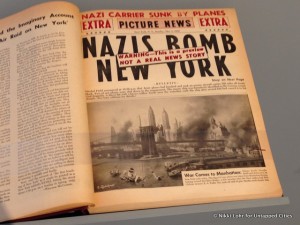For Readers of Skating with the Statue of Liberty: Anti-Semitism in the United States in the 1940s
Anti-Semitism in the United States in the 1940s
A Guest Post by Catherine Maryse Anderson
Susan Lynn Meyer’s novel Skating With the Statue of Liberty opens in 1942 on board a transport ship bound for America. Gustave and his family are on that ship to escape the persecution of Jews in their native France. As has been the case for immigrants and refugees arriving to the United States throughout history, their expectations and the reality of life in the United States differ. Gustave expects he is leaving anti-Semitism and prejudice behind in Europe.
Anti-Semitism, or hostility toward or discrimination against Jews as a religious, ethnic, or racial group (Source: Merriam Webster), has plagued the world for more than 2,000 years. Jews arriving in the United States in the 1940s found that America was not free of this blight.
Gustave’s family encounters anti-Semitism in both subtle and overt ways. On their very first train ride to New York, Gustave’s hope of living without racial and religious prejudice is shattered:
“Refugees,” Gustave heard a man say. Then from behind him, he heard a woman utter a one-syllable word. It was the first time he had heard the word in English, yet somehow he knew what it meant. He knew that tone of voice. It was the same tone of voice in which he had heard certain people in France hiss “juifs,” the same tone of voice in which Germans spat out “Juden.” He hadn’t thought he would hear that particular mixture of repulsion and smug superiority here in America. But he had. The woman had muttered “Jews.” —Skating With the Statue of Liberty, p. 28.
As you are reading the novel, notice when the author depicts other anti-Semitic encounters. Is such prejudice exhibited at Gustave’s school or in the family’s search for housing? Have you experienced subtle or outright hostility directed at your cultural background or religious beliefs? If you haven’t had that experience, how does the author help you to understand what it feels like?
While the origins of racism and prejudice are deeply complex, anti-Semitism in the U.S. in the 1940s was fueled by unjust propaganda from Europe. For example, after World War I, the German government claimed that the Communist Jews, acting as spies, caused the Germans to lose the war. The Germans warned that the Jews, and thus Communism, could take over Europe. This fear of the spread of Communism (a form of government that was considered a great threat to democracy) was echoed by xenophobes in the United States. Anti-communism fed anti-Semitism.
Others in America feared that Hitler’s mad conquest of Europe would expand to an attempted takeover of the United States. Propaganda and rumors were spread that Jewish refugees in the United States were acting as German spies in exchange for protection of their families in Europe. Anti-German feelings fed anti-Semitism.
Other Americans believed, as they have with every new population of refugees, that the new arrivals would take away housing or jobs from long-term Americans. Anti-immigration feelings feed anti-Semitism.
Looking back, it is hard to believe that anti-Semitic Americans were not jolted out of their xenophobia in the face of the extreme anti-Semitic atrocities being committed against the Jews in Europe. In the early 1940s, however, many Americans did not know about the Holocaust.
In 1942 the United States Department of Justice withheld a report from the World Jewish Congress about the Nazis’ threat to annihilate the Jews. Fearing that this horror could be only a rumor and that the United States would have no success in a large-scale rescue attempt, the government did not act and did not inform citizens. It was not until 1944 that President Roosevelt, under pressure from his own government and the American Jewish community, took public action to rescue European Jews.
If the U.S. government had shared the information from the World Jewish Congress with the American people in 1942, do you think the U.S. would have acted sooner to aid the Jews? How would this information have changed the perception and welcome of refugees like Gustave and his family? How does their experience compare to that of those seeking asylum in the United States today?
How can extreme expressions or acts of prejudice make people reassess their own views? Have you ever shared an opinion with someone, but changed your opinion when you saw that person do something you did not like or respect?
Resources & Sources
Antisemitism Bibliography from the United States Holocaust Memorial Museum
“Antisemitism” from Holocaust Encyclopedia of the United States Holocaust Memorial Museum
Image Sources:
Image 1: Anti-semitic Poster Equating Jews with Communism. United States, 1939
Source: Jewish War Veterans Museum
Image 2: Fake Cover of New York City’s PM Newspaper Warns of Possible Future German Takeover
Source: Untapped Cities
About the Educator:
Catherine Maryse Anderson has an extensive 15-year background as a public school literacy and humanities teacher in Portland, Maine. She spent two years as a literacy coach for Portland Public Schools and led statewide symposiums on building educator capacity for cross-cultural competency in the classroom from early childcare through college. She was a runner up for the Teaching Tolerance Educator of the Year. Catherine has been involved in ongoing performing arts projects for twenty years and is a published poet and essayist.
